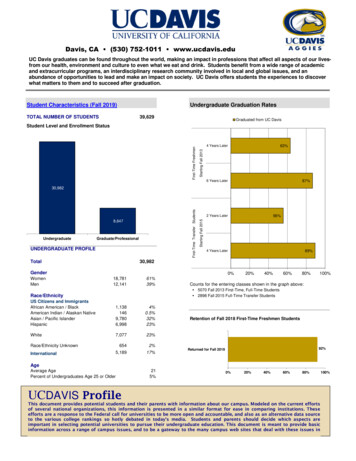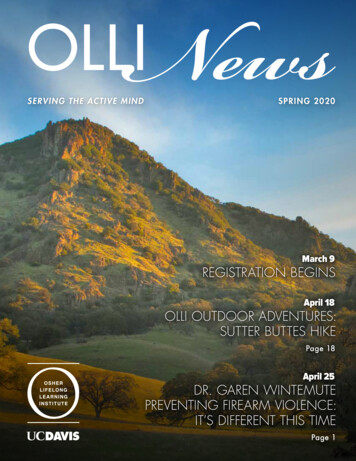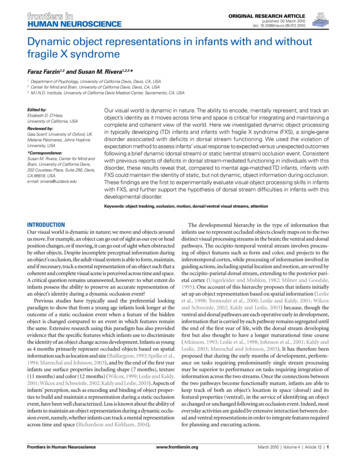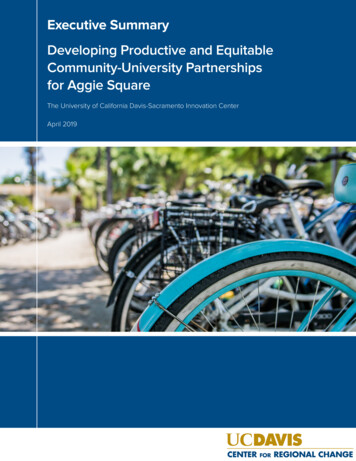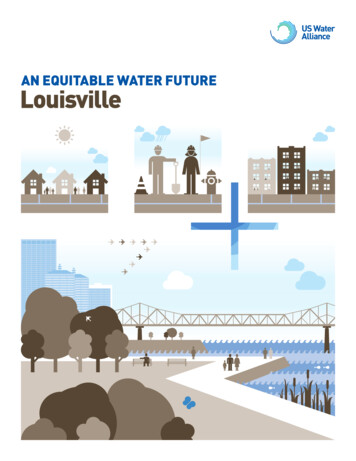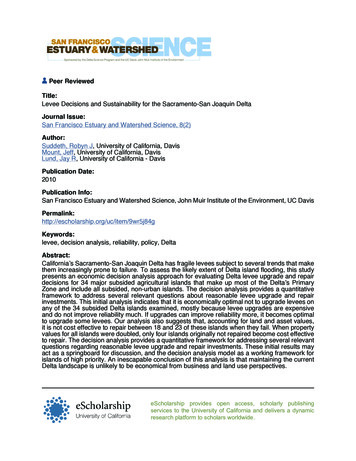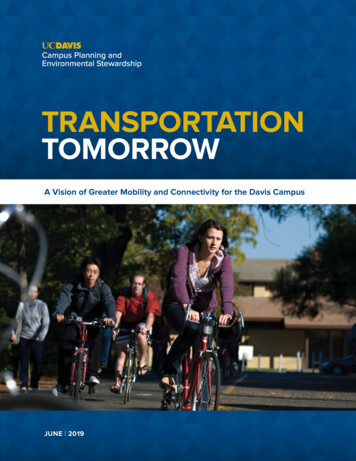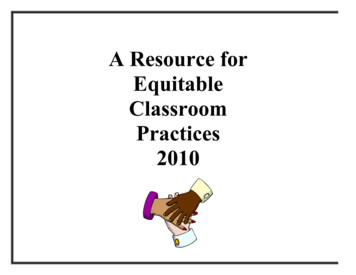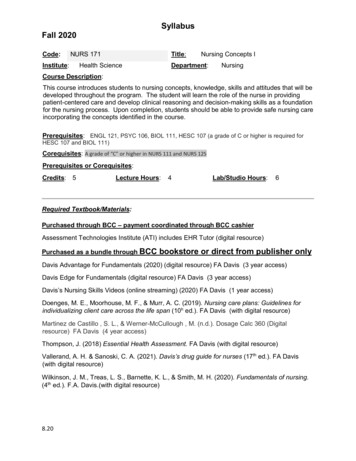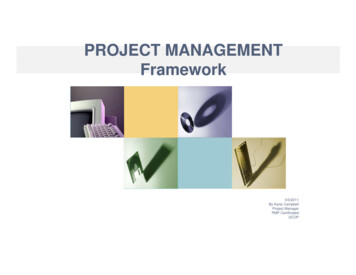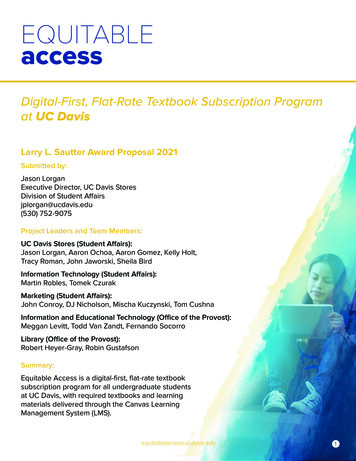
Transcription
EQUITABLEaccessDigital-First, Flat-Rate Textbook Subscription Programat UC DavisLarry L. Sautter Award Proposal 2021Submitted by:Jason LorganExecutive Director, UC Davis StoresDivision of Student Afairsjplorgan@ucdavis.edu(530) 752-9075Project Leaders and Team Members:UC Davis Stores (Student Afairs):Jason Lorgan, Aaron Ochoa, Aaron Gomez, Kelly Holt,Tracy Roman, John Jaworski, Sheila BirdInformation Technology (Student Afairs):Martin Robles, Tomek CzurakMarketing (Student Afairs):John Conroy, DJ Nicholson, Mischa Kuczynski, Tom CushnaInformation and Educational Technology (Ofce of the Provost):Meggan Levitt, Todd Van Zandt, Fernando SocorroLibrary (Ofce of the Provost):Robert Heyer-Gray, Robin GustafsonSummary:Equitable Access is a digital-frst, fat-rate textbooksubscription program for all undergraduate studentsat UC Davis, with required textbooks and learningmaterials delivered through the Canvas LearningManagement System (LMS).equitableaccess.ucdavis.edu1
Before Equitable Access 78% of UC Davis studentsindicated they did not have access to all theirrequired materialsThe ProblemTextbooks have become increasinglyexpensive and prices vary widely bymajor. This has contributed to inequityon campus because not all students canaford their required course materialsand acquiring them can be a complexprocess. During the winter quarter of2020 before Equitable Access began,students were asked if within theprevious 12 months, they did not rent,purchase or acquire at least one requiredtextbook. 78% of UC Davis studentsindicated they did not have access toall their required materials. In addition,traditional textbooks are no longer theonly learning materials faculty require intheir courses. Traditional textbooks, OpenEducational Resources (OER), homeworkplatforms, library resources, and adaptivecourseware are among the learningmaterials assigned by faculty on campustoday. This wide variety of content andwhere to acquire it has caused confusionand delays in obtaining course materials.The goal of this program was to reduceinequity among students by eliminatingcourse material access issues, whileensuring that costs are predictable andequal for all undergraduate students.The SolutionUnder Equitable Access, allundergraduate students are enrolledby default and pay the same fat rate of 199 per quarter regardless of their majorand courses. For students who remainin Equitable Access, all required contentis delivered through the LMS by the frstday of class. When students add or dropcourses, their digital textbooks move withthem automatically so they can stay focused on theirstudies. If students prefer to obtain textbooks ontheir own, they are free to opt out of the programeach term.The InnovationBy pooling all undergraduate students together,innovative cost savings were achieved duringprice negotiations with publishers. The operationalefficiency of the program creates opportunity forsavings far beyond the traditional print modelthat most college campuses have employed fordecades. Based on the performance of the programthis academic year, there will be a reduction inthe price of Equitable Access in fall 2021. At theend of each academic year, an actuarial sciencefrm will analyze the performance of the fundand recommend the next year’s rate. This annualactuarial analysis was inspired by the UC StudentHealth Insurance Program (UC SHIP).equitableaccess.ucdavis.edu2
Lower income students no longer have to worry abouttextbook costs varying based on their courses or majorThe ImpactAfter launching Equitable Access, the number ofstudents with access to their required textbooks hassignifcantly increased. Students now have a singleconvenient location for day one access to all oftheir textbooks; they no longer have to worry aboutreturning textbooks as they add or drop classesbecause their textbooks move with them automaticallyin the LMS. For the 15% of textbooks that are notavailable digitally, students can either pick up theirtextbooks at the campus store or can request to havethem shipped at no additional cost. One low fat ratemeans costs are predictable for students. Additionally,those who receive fnancial aid for their textbookpurchases can easily apply those funds as the programoperates within the campus billing system. Perhapsmost importantly, lower income students no longerhave to worry about textbook costs varying based ontheir courses or major.Number of studentswith access to all oftheir textbooks beforeEquitable Access6,819Number of students withaccess to all of theirtextbooks afterEquitable Access22,6615,00010,00015,00020,000The NumbersThe success of Equitable Access was primarily measured by the increase in the number ofundergraduate students with access to all their required textbooks before and after the programlaunched. In the winter quarter of 2020, UC Davis undergraduate survey data indicated that 78% ofstudents claimed they did not have access to all their required textbooks. After Equitable Access, thenumber of students who claimed they did not have access to all their required textbooks plummeted to27%. Stated diferently, before the program began, 6,819 students claimed to have access to all of theirrequired textbooks. This number grew to 22,661 after Equitable Access launched. Another importantmeasure of the program’s success was student satisfaction. For students who participated in EquitableAccess, 79% said that they would recommend the program to other students, 71% said that theprogram was easier to use than shopping for textbooks on their own, and 60% said that conveniencewas the primary reason for remaining in the program.equitableaccess.ucdavis.edu3
The CollaborationLaunching Equitable Access required successful collaboration with many departments on campus.Academic Technology Services, which manages the campus Learning Management System is a criticalpartner in this program, as textbooks and other course content are accessed through the LMS. Courserosters from the University Registrar are regularly updated in the LMS to manage student accessto textbooks as courses are added and dropped. Collaboration with Student Accounting integratesprogram billing into the tuition and fee payment process, which allows easy application of availablefnancial aid dollars to pay for the program. Signifcant collaboration with the University Library is alsoa key feature of this program. Over 400 Library-owned digital resources that faculty have assignedfor their courses are currently included within the LMS. Each quarter, the bookstore reviews licensedlibrary content availability and links textbooks that match faculty-assigned content to the LMS. Thiscollaboration provides signifcant savings to the institution (over 400,000 in the frst year); as programcosts decline, this will contribute to reducing the price of Equitable Access in future terms.The TimelineEquitable Access was developedbetween 2018 and 2020.Initial meetings with educationtechnology and campus partnerswere followed by publisher pricenegotiations, actuarial analysisto determine pricing, and thedevelopment of the technologyto run the program. Our work alsoincluded receiving feedback froma steering committee of UC Davisundergraduate students; as theprogram was being developed,student feedback was regularlysought and incorporated.Meetings with numerous campusdepartments to facilitate the launchof the program occurred during thistwo-year period. After extensivestudent and campus outreachcampaigns, the program launchedto all UC Davis undergraduatestudents in fall quarter of 2020.We are currently nearing the endof our third academic term with theprogram in efect.Meet with educationaltechnology partnerVerba Software todiscuss scaling a digitaltextbook programBegin work ondeveloping EquitableAccess as a digital-frst,fat-rate, subscriptiontextbook programOct 2018Oct 2018Oct 2018Dec 2018Begin work withactuarial frm todetermine studentprice per quarterCreation of the studentsteering committeeJan 2019Jul 2019Academic departmentand faculty outreachprogram begins andcontinues throughMarch 2020Sept 2019Begin campus andstudent awarenesscampaign (includingprint, digital andsocial media)Nov 2019Begin collaboration withUC Davis Library to postdigital library resourcesto Canvas LMSMay 2020Nov 2019Dec 2019Sept 2020equitableaccess.ucdavis.eduMeetings with AcademicTechnology Services,Student InformationSystems, Library andFinancial Aid to begincollaborative planningPublisher pricenegotiations beginand continue throughJune 2020Begin work with CanvasLMS to allow studenttextbook access for allclasses (including thosefor which faculty havechosen not to publish acourse page)Launch EquitableAccess website(equitableaccess.ucdavis.edu)Launch of EquitableAccess program4
The TechnologyStudents are provided immediate digitalaccess to their required course materialsthrough the use of VitalSource’s singleLearning Tools Interoperability (LTI) tool.The LTI tool securely connects studentsto digital content delivered in bothVitalSource Bookshelf and providerhosted courseware inside of the CanvasLMS. The technology combines adoptiondata from the student information system,the retail management systems andcourse rosters from Canvas to present apersonalized experience for each studentacross all courses in the current term.This integration and partnership supportsmultiple content fulfllment sources,ranging from proprietary platforms tothe campus library to present a unifed,comprehensive use of resources resultingin a superior student experience.The technology combinesadoption data from the studentinformation system, the retailmanagement systems andcourse rosters from Canvasto present a personalizedexperience for each studentacross all courses in thecurrent term.Learning Tools Interoperability (LTI)Learning Toolse.g. anagementSystem (LMS)equitableaccess.ucdavis.edu5
measure of the program's success was student satisfaction. For students who participated in Equitable Access, 79% said that they would recommend the program to other students, 71% said that the program was easier to use than shopping for textbooks on their own, and 60% said that convenience was the primary reason for remaining in the program.
